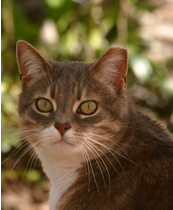What are Feral Cats?

Feral cats are neither wildlife nor pets, therefore they do not benefit from belonging to either group. Abandoned by their human families or simply lost, house cats eventually band together for safety in groups called colonies. Without positive human contact for a prolonged period, the cats in these colonies become feral (wild). Feral mother cats teach their kittens to avoid humans and to defend themselves in order to survive. A feral cat will not trust humans and will most likely not allow a human to get within a certain distance.
They make their homes wherever they can find food and shelter. There may be colonies of feral cats near restaurants, business complexes with dumpsters or in neighborhoods where parks or trees provide protection and shelter. Although these cats may be nearly invisible, they are part of our communities. They live in our parks, alleys, abandoned buildings, greenbelts, college campuses and rural areas.
No one knows exactly how many feral cats live in the United States, but the number is estimated to be in the tens of millions. They are often wrongly portrayed as disease-ridden nuisances living tragic lives and blamed for being responsible for endangering native species. Consequently, feral feline communities too frequently are rounded up, and because they are deemed unadoptable, they are euthanized.
Removing and killing feral cats does not reduce feral cat populations. It only provides space for more cats to move in and start breeding again.
Unspayed feral female cats spend most of their lives pregnant and hungry. Unneutered males may roam great distances in search of females. They fight with other males, often resulting in debilitating wounds. It is estimated that half of all kittens born in feral colonies die within their first year.
Are All Free Roaming Cats Feral?
A “free roaming” cat, on the other hand, is not necessarily feral. A free roaming cat may be defined as a cat living outdoors at least some of the time. This could be a pet cat that is allowed to spend time outdoors, a lost or abandoned tame cat. Quite often, a free roaming cat is mistakenly identified as a feral cat. It is usually very difficult to accurately assess the degree of tameness of a free roaming cat.
However, once a cat is caught, there are ways to determine if it is truly feral or simply frightened. Experienced trappers and cat rescue organizations are able to determine if a free roaming cat is feral or just acting feral due to fear or injury. Once caught, homeless free roaming cats which are tame can be placed for adoption in homes where they will be protected from the dangers and struggles of outdoor life.
Trap, Neuter, Release/Return (TNR) – A Program that Works!!
There is a solution that not only reduces the feral cat population, but also improves and extends the lives of existing colony members: TNR.
TNR is a comprehensive plan where entire feral colonies are humanely trapped, evaluated, vaccinated and spayed/neutered by veterinarians. Kittens and cats that are tame enough to be adopted are placed in good homes. Adult cats deemed to be feral are returned to live out their lives in managed colonies where they are being fed and monitored by caring humans.
TNR works! Cat populations are gradually reduced. Nuisance behaviors associated with breeding, such as yowling females or the spraying and fighting of male tomcats are virtually eliminated. The general health and well-being of these cats is greatly improved. The cats live healthy, safe and peaceful lives in their territories.
In addition, feral cats can provide natural rodent control in our neighborhoods. Neutering and spaying feral cats reduces the number of kittens impacting local shelters each year. This has a substantial positive effect on euthanasia rates and helps to solve the cat overpopulation crisis.
Myths and Facts about Feral Cats and TNR
Myth: It is easier to eradicate a colony by trapping and killing.
Fact: Eradication has never been an effective way to control any animal population. When animals are removed from a location, new animals move in to take advantage of the food source. This is called the “vacuum effect”.
Myth: Feral cats have a high rate of diseases.
Fact: Cats in managed colonies are examined, altered and vaccinated by veterinarians. Statistics show that feral cats are no more likely than house cats who spend time outdoors to have acquired feline leukemia virus (FeLV) or feline immunodeficiency virus (FIV).
Myth: Feral cats cause a significant decrease in bird and wildlife populations.
Fact: While cats are predators by nature, responsibility for the decline in bird and wildlife population falls squarely on the shoulders of the human species. The United States Fish and Wildlife Service reports that humans have overtaken vast areas of natural habitat, forcing out the nesting songbirds and other forms of wildlife on the endangered species lists. Drought, pollution, and pesticides have also contributed to the toll on wildlife.
How Can I Get Involved to Help Feral Cats?
MEOW Cat Rescue has traps available to humanely trap cats. Your $70 deposit is fully refundable upon return of the trap.
Trapping is not difficult but it does require some planning and instruction. Please read our Trapping Guidelines before starting your project.
There are several organizations in the Puget Sound area offering information and assistance with feral cat spay/neuter and colony management.

